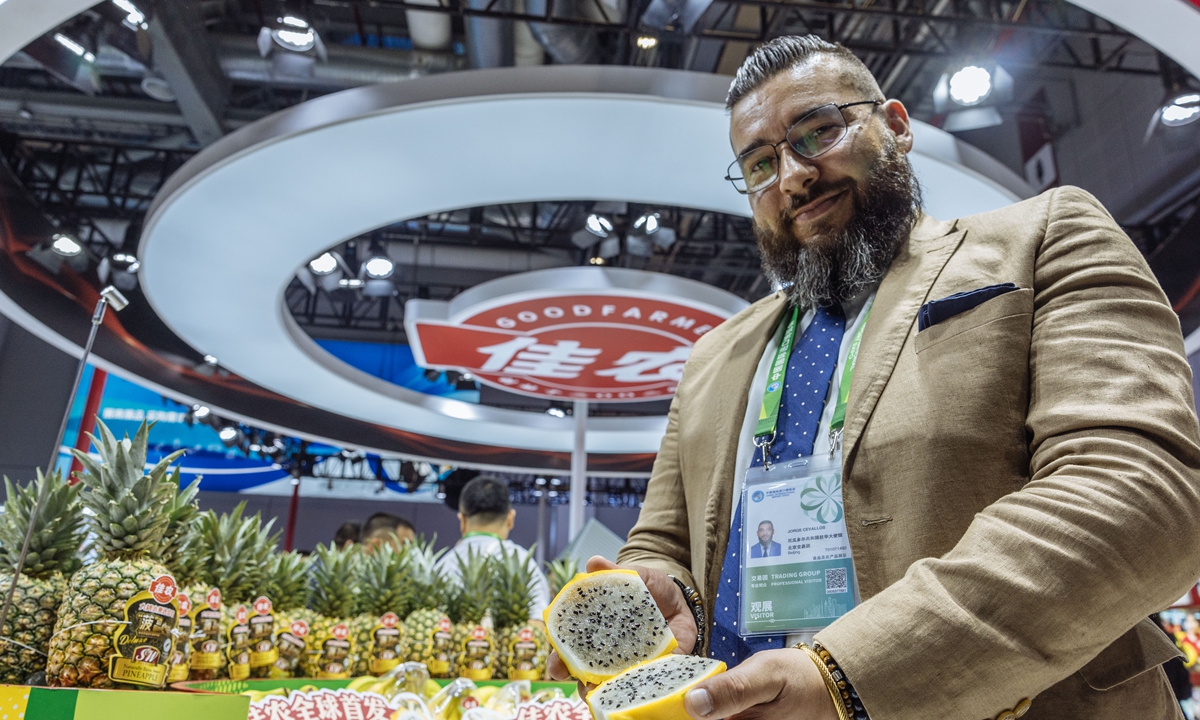
Jorge Cevallos, commercial counselor of the Ecuadorian Embassy to China, shows the yellow dragon fruit at the 6th CIIE held in Shanghai. Photo: Li Hao/GT
Foreign fruit exporters are intensifying their efforts to access the extensive Chinese consumer market at the 6th China International Import Expo (CIIE), the world's largest import fair, held in Shanghai from November 5 to Friday, reflecting China's status as the world's largest fruit consumer.
From Mexican bananas to Panamanian pineapples, a variety of fruits from different countries and regions have been on show at the expo, as the Chinese market embraces diverse and high-quality agricultural products amid a consumption upgrade.
Fresh fruit and vegetable giant Dole has participated in the CIIE since its first edition in 2018. This year, Dole is showcasing more than 70 fruit and vegetable products, including the global launch of the Philippines' Golden Puyat Durian and papayas, the Global Times learned.
"We see this event as a great opportunity for business expansion. We have seen a 200 percent sales gain in South China due to the previous CIIEs," Nie Dan, a product promotion manager of Dole, told the Global Times on Thursday.
In addition to the traditional products, many have appeared in the Chinese market for the first time.
The initial shipment of Benin pineapples, recently granted quarantine access to the Chinese market, was cleared by customs at Shanghai Pudong International Airport and appeared at this year's CIIE.
Additionally, Kandahar pomegranates from Afghanistan entered the expo, the first time they've been on show with the public in China.
Ecuador brought yellow dragon fruit to the CIIE. This marks the first instance of Shanghai Port importing Ecuadorian yellow dragon fruit since China's General Administration of Customs (GAC) approved this category for import in 2022. It's a significant step for both countries to boost bilateral trade following the successful conclusion of the China-Ecuador Free Trade Agreement (FTA) negotiations in February this year.
Jorge Cevallos, commercial counselor of the Ecuadorian Embassy to China, told the Global Times on Thursday that Ecuador just started exporting this fruit in April.
"We are very confident in the Chinese market, which is a very strong market with a lot of consumers, and there is a lot of taste for good fruit. It is subject to a 20 percent tariff at the moment, but after the free trade agreement we just signed [comes into force] it will be much cheaper for Chinese consumers," Cevallos said, noting that the crop can diversify Ecuadorian exports to China.
As the world's largest fruit producer and consumer, China consumes nearly 70 percent of the world's watermelons and almost half of its apples, along with being the largest consumer market for kiwifruit.
With the extensive implementation of various cooperation agreements such as the FTA and the Regional Comprehensive Economic Partnership, coupled with the introduction of policies like low tariffs and efficient inspection and quarantine processes, more types of imported fruits have entered the Chinese market.




